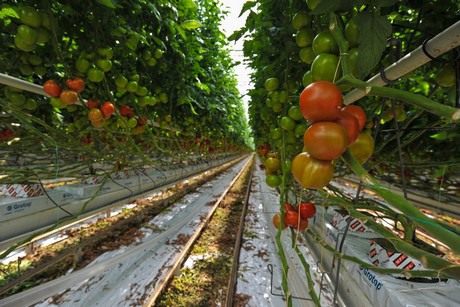 While, to some, it may seem like a tomato is a tomato, there are actually important distinctions between the items in the produce aisle. Aside from the different varieties and grades of produce, an important difference has to do with the way produce is grown. On one end of the spectrum is the old, open-field method of production, and on the other end are the high-tech hydroponic greenhouses that are the way of the future. But even among produce that is purported to be greenhouse-grown, not all tomatoes are alike. To address the issue, Certified Greenhouse Farmers (CGF), a trade association made up of greenhouse growers throughout North America at the top of their industry, has set certification guidelines to let people know exactly what it means when something is greenhouse grown.
While, to some, it may seem like a tomato is a tomato, there are actually important distinctions between the items in the produce aisle. Aside from the different varieties and grades of produce, an important difference has to do with the way produce is grown. On one end of the spectrum is the old, open-field method of production, and on the other end are the high-tech hydroponic greenhouses that are the way of the future. But even among produce that is purported to be greenhouse-grown, not all tomatoes are alike. To address the issue, Certified Greenhouse Farmers (CGF), a trade association made up of greenhouse growers throughout North America at the top of their industry, has set certification guidelines to let people know exactly what it means when something is greenhouse grown. “There's no definition for what's a greenhouse tomato, or for what is a greenhouse cucumber,” said CGF's Ed Beckman. “You can put anything you want in a box and label it greenhouse-grown, and right now, it's allowed, but it's not good for the industry or the consumer.” One of the biggest faults with the current system is that consumers, who regularly pay up to 40 cents per pound more for greenhouse produce than they do for conventional produce, are often not getting what they deserve.
“There's no definition for what's a greenhouse tomato, or for what is a greenhouse cucumber,” said CGF's Ed Beckman. “You can put anything you want in a box and label it greenhouse-grown, and right now, it's allowed, but it's not good for the industry or the consumer.” One of the biggest faults with the current system is that consumers, who regularly pay up to 40 cents per pound more for greenhouse produce than they do for conventional produce, are often not getting what they deserve.“Consumers shouldn't be paying a premium unless it's actually greenhouse-grown,” said Beckman. “But, unfortunately, there are not standards to guarantee that right now.” CGF wants to remedy the situation with a set of guidelines that specify exactly what can be considered greenhouse produce. They offer certification for growers who meet their guidelines, and there are about 40 growers throughout the US, Canada and Mexico who currently meet CGF standards.
“In order to be certified, a grower has to meet specific standards that include the use of a glass or impermeable plastic greenhouse, hydroponics, a computerized climate control system and a dedication to using integrated pest management solutions over pesticides,” explained Beckman. He added that there's a strong sustainability component that ensures certified growers focus on recycling water used for irrigation and minimizing waste through waste management practices for packaging, product waste and non-chemical waste. Those standards provide consumers with information which many of them are increasingly concerned about, and adopting those standards and promoting them to the general public guarantees that discerning consumers will be aware of the benefits of buying hydroponic greenhouse produce. But Beckman explained that the benefits of certification go beyond the consumer; they go to the core of the industry.

“One of the challenges we faced when CGF was formed in 2008 was the salmonella outbreak associated with in tomatoes,” said Beckman. “It turned out that the source of contamination was traced back to peppers, but for a long time the FDA painted the entire industry with a wide brush; all tomatoes were suspect.” Because there wasn't much knowledge among consumers or the government about the distinction between open-field tomatoes and greenhouse-grown hydroponic tomatoes, everyone assumed that it was just as dangerous to eat a greenhouse tomato as it was an open-field one. Because of the different growing standards in place in each method of production, that's not the case, but a scared public couldn't tell the difference. So greenhouse growers suffered from the salmonella scare just as much as everyone else. With certification, there's a way to let consumers know the difference.
“We have a crisis management team on call all the time, so if there's ever something that needs to be addressed we go into action to present a unified dialogue to the government and the media,” said Beckman. Because it's nearly impossible for an individual grower to address a health scare on his own, the unified message CGF can provide is also a great asset to all certified greenhouse growers.
“Our program is geared to monitor events,” said Beckman. “We want to dialogue with the government on issues before it costs our growers money.”
For more information: www.certifiedgreenhouse.com
